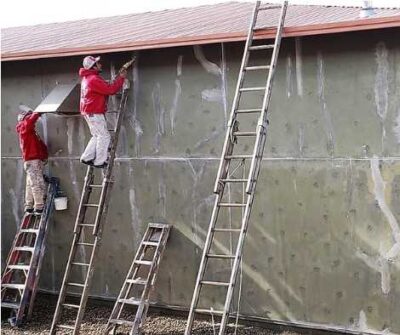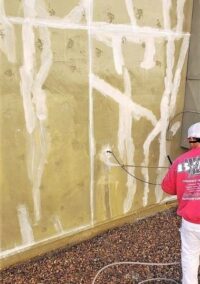Tips for painting stucco
Stucco requires very minimal upkeep and is primarily a maintenance-free finish, provided that you have sound stucco walls that were applied correctly. Hopefully, these tips for painting stucco will be a useful resource.
STUCCO: Why So Popular in Desert Climates?
A cement-based siding that adds a textured finish to exterior or interior walls–made from a mixture of cement, sand, water and lime. Stucco resists heat and dryness well and comes in a variety of colors and textures.
Stucco is a strong coating that will stand the test of time and the Arizona sun if it’s applied correctly in the first place, painted regularly, and repaired whenever there are cracks or other damage to its surface.
Even though the high-desert of Central Arizona is known for its hot temperatures, it can also get pretty frigid at night and in the winter, making the costs of heating and air high year-round. Stucco is energy efficient and provides insulation for the buildings or home, helping to cut these costs.
Best Way to Paint Stucco
Before we paint, B&M painting will inspect for any damaged areas. Where needed we will employ a stucco repair kit and let it dry for several days. Then, we will pressure wash the walls and remove any mold. Only then are we ready to apply primers.
Paint stucco with a roller or an airless sprayer rather than a brush. A roller is great for little chores, but it can be difficult to use for larger projects. When using a paint sprayer, the B&M Paint pros take time to spray every surface with precision so that the paint adheres completely.
Next is the application of masonry paint around the doors and windows. B&M Painting always applies a minimum of 2 coats of paint to surfaces. We follow up by removing the painter’s tape and inspect the project for quality and completeness.
Here is more information about our stucco repair services.
Is Elastomeric paint the way to go?
Elastomeric paint is a high-build protective covering for brick, stucco and concrete surfaces. Elastomeric paint is newer than other types of home paint. However, when you’re looking for versatile paints that can withstand moisture and other conditions, it’s the way to go. There are numerous advantages to utilizing elastomeric paint, ranging from waterproofing to durability, which explains its widespread use in home and commercial painting projects. Elastomeric paint has a more durable composition and a thicker coating than most other paints.
Elastomeric paints have all of these advantages, but they are not always required. A masonry primer and two coats of good exterior paint will give you amazing results for a lot less money. If your stucco has numerous layers of paint, it may not be a good idea to repaint it with elastomers.
Optional Paint Choices for Stucco
We’ve mentioned elastomeric paint; however, acrylic paint and masonry paint could be other options. Keep in mind that stucco requires paint that can expand and compress. It should also be highly long-lasting, mildew and dirt-resistant, waterproof, and supple to avoid cracking.
- Acrylic paint – It’s long-lasting and adaptable. Satin or semi-gloss paint finishes are even better because they are more water-resistant.
- Masonry paint – This paint is designed to adhere to masonry substrates such as cinder blocks, concrete, and stucco, is long-lasting and resistant to moisture and mildew. Its thick formula is one of the few possibilities for concealing hairline cracks in stucco surfaces, and it is a good option for water resistance.
Take your time and consult with B&M Painting first. We are stucco professionals and can help determine the very best options for your project.
Call B & M Painting
At B & M painting, we are experts in residential and commercial painting. You can learn more about our stucco painting services HERE.
PROFESSIONAL SERVICES DONE RIGHT! We can make “‹”‹your next project run smoothly and delivered with excellence.
Give us a call at 928-636-8281. Send us an email at jason@bandmpaintingaz.com and visit our website HERE.







